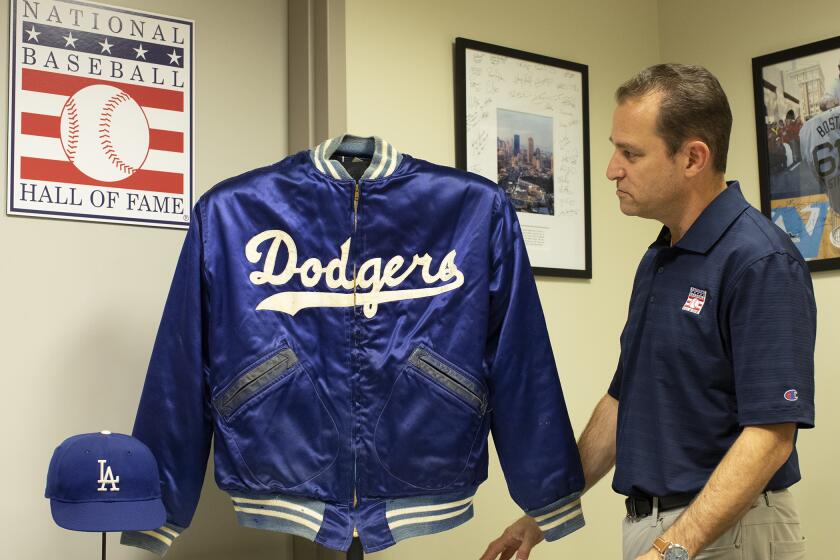Like Cone, Ford and Koufax Had Circulatory Problems
- Share via
NEW YORK — Although the mystery surrounding the condition of David Cone’s right hand has been solved, the suspense remains. While doctors have identified the apparent source of the pitcher’s numb finger as a “very small aneurysm” in his right shoulder, there remains the matter of treatment. When, where or even if the man will undergo surgery has yet to be determined.
All the Yankees have announced to date is that Cone has been placed on the 15-day disabled list, a technicality that doesn’t begin to suggest the severity of the ailment. The discovery of the arterial weakness at Columbia-Presbyterian Medical Center at least rules out several other possibilities. Compared to the sources of circulation problems suffered by other elite pitchers in the previous three decades, the news could have been better. It could have been worse.
Certainly, J.R. Richard never knew what hit him on that July afternoon in 1980 when he collapsed at the Astrodome from a stroke. In the previous two years, the 6-foot-8 right-hander had led the National League in strikeouts with 303 and 313, and he appeared en route to his best season, compiling a 10-4 record with a miniscule 1.90 earned run average at the All-Star break. Still, he had been complaining of a “dead arm,” leading some members of the media to speculate he was either a hypochondriac or involved with drugs.
In the course of a three-day stay at Houston’s Methodist Hospital, doctors discovered Richard hadn’t imagined the fatigue. They diagnosed a circulatory problem affecting the flow of blood to his arm. Still, they released him on July 29, only one day before he was stricken. Emergency surgery was performed to removed a blood clot behind his right collarbone.
The 30-year-old pitcher was partially paralyzed on the right side and remained hospitalized for approximately six weeks. A month after his release, he entered Moffitt Hospital in San Francisco, where surgeons replaced an obstructed artery in his right shoulder and rebuilt his damaged vascular system during an 18-hour operation. Richard never pitched again. He also endured two broken marriages and a string of bad investments that left him bankrupt and temporarily homeless.
More fortunate -- both in baseball and life -- was Whitey Ford, like Cone the ace of the Yankees’ staff. His world suddenly stopped spinning in the sixth inning of the first game of the 1964 World Series at Busch Stadium.
Shortly after the St. Louis Cardinals defeated the Yankees in seven games, the 35-year-old Ford underwent a sympathectomy in Houston. The surgeon was none other than Denton Cooley, the famed heart specialist. He placed a silver clip on a nerve in the shoulder and decided not to clear up the blocked artery in the expectation that open capillaries would supply enough blood to the hand.
Ford enjoyed a successful season in 1965, winning 16 games in 29 decisions for a deteriorating team that plunged from first to a distant sixth in the American League. But his fingers grew numb when he pitched, particularly in cold weather. The solution was a small hot water bottle with which the slick left-hander warmed his digits on the mound. Only one manager, Detroit’s Charlie Dressen, objected.
But the circulation deteriorated and the pain increased in 1966. After making only nine starts and winning two games, Ford submitted to a second operation by Cooley. This time, the artery was bypassed with a vein transplanted from Ford’s left leg. The man began the 1967 season in spectacular fashion, tossing a shutout and maintaining an ERA of 1.58 through his first five starts.
But after he started experiencing elbow trouble, he announced his retirement on May 30, terminating a Hall of Fame career after 236 victories against only 106 defeats. “I still talk to Dr. Cooley every year,” Ford said. “He sent me a clipping one year that said if I wasn’t left-handed, what happened to J.R. Richard might have happened to me.”
The clip from the first operation prevented Ford from sweating on the left side from his waist to the top of his head. “It looks funny with a yellow golf shirt to see sweat on one side and not the other,” he said with a laugh. At least, the second operation restored his pulse.
An elbow problem also ended the glittering career of Sandy Koufax at the tender age of 30. Before he retired in 1966, however, the Dodgers’ left-hander pitched four no-hitters, including a perfect game, and won five consecutive National League ERA crowns. Yet, baseball almost was deprived of Koufax’ best by the loss of circulation to his index finger in 1962.
That was the year when the pitcher blossomed, striking out 18 Cubs and recording his first no-hit game against the Mets (with a numb finger, he later pointed out). But when the discolored finger continued to deteriorate, Koufax was sidelined for two months in the midst of a pennant race. According to research unearthed by the Baseball Hall of Fame library, when a blood clot in the artery of the palm developed, surgery was considered. “The doctor didn’t tell me until after the crisis had passed,” Koufax related later that season. “He told me if the clot hadn’t been dissolved, it might have been necessary to have the finger amputated.”
Although he was of little use to the Dodgers in their losing playoff series against the San Francisco Giants, lasting only two batters into the second inning of his start in Game 1, the treatement with drugs restored him to top condition in time for the 1963 season. All he did that year was win 25 games, throw 11 shutouts, strike out 306 batters and beat the Yankees twice in the World Series.
Ironically, the losing pitcher in both those games was none other than Whitey Ford.
More to Read
Go beyond the scoreboard
Get the latest on L.A.'s teams in the daily Sports Report newsletter.
You may occasionally receive promotional content from the Los Angeles Times.










